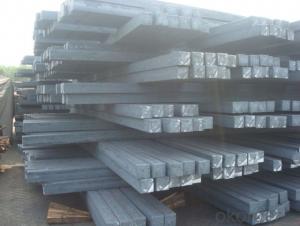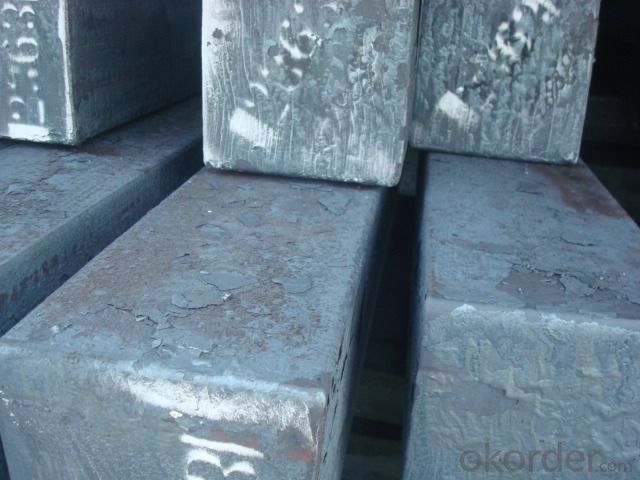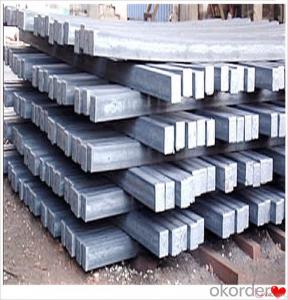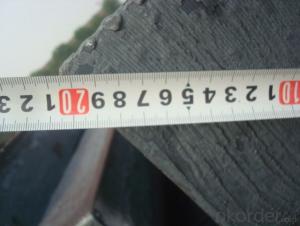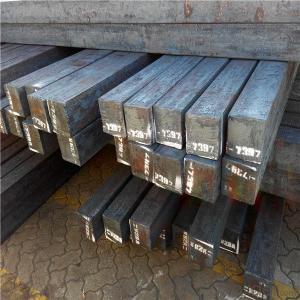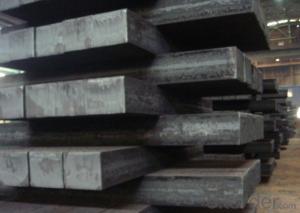Continuous Casting Steel Billet in Amazing Price
- Loading Port:
- Tianjin
- Payment Terms:
- TT OR LC
- Min Order Qty:
- 1000 m.t.
- Supply Capability:
- 200000 m.t./month
OKorder Service Pledge
OKorder Financial Service
You Might Also Like
STEEL BILLET
1.Structure of Steel Billet
Steel billet(ingot) by cogging or breakdown of semi-finished products, is the raw material of all kinds of steel mill. Billet section of square, round, flat, rectangular and abnormity of several kinds of, mainly related to the shape of rolled products.
2.Main Features of Steel Billet
Rectangular billet continuous casting billet and mainly general carbon steel, low carbon low silicon cold-rolled material, high quality carbon structural steel, high strength low alloy steel, special steel, etc.
The billet is mainly divided into two kinds from the shape:
Slab: cross section width and height of the ratio of the larger, mainly used for rolling plate.
Billet: equal cross section width and height, or a huge difference, mainly used for rolling steel, wire rod. ,
Steel billets have distinct characteristics as compared with already furnished steel bars and products. Billets have a specific grain structure, which enables the metal to be processed more intricately. Steel billets are also known for their malleability and ductility, especially when exposed to varying temperatures during shaping and molding.
3.Processing of Steel Billet
Steel billets are considered fresh and raw, and they must undergo a series of manufacturing processes before they can be used for various purposes. Billets are made by means of freezing molten liquid, and are later exposed to extremely low temperatures in order to allow the metal to take shape and solidify in chemical structure. The temperature manipulates the metal's physical properties, and tones its strength and durability. The subsequent processes provide the metal's curved mold design so that it can fit the allotted space provided by other machines, which complete the finishing procedures.
4.Steel Billet Images
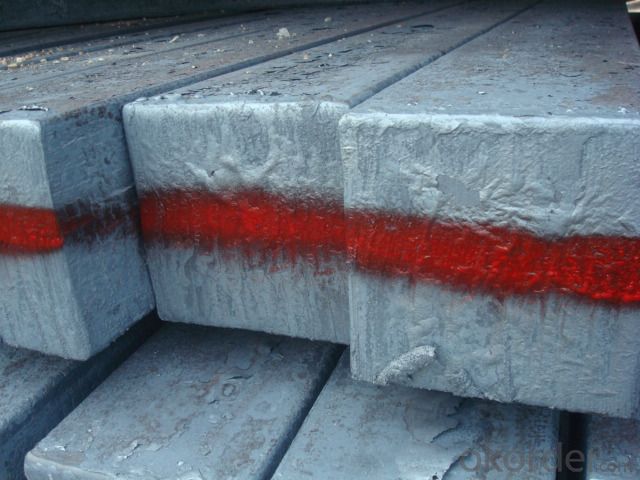
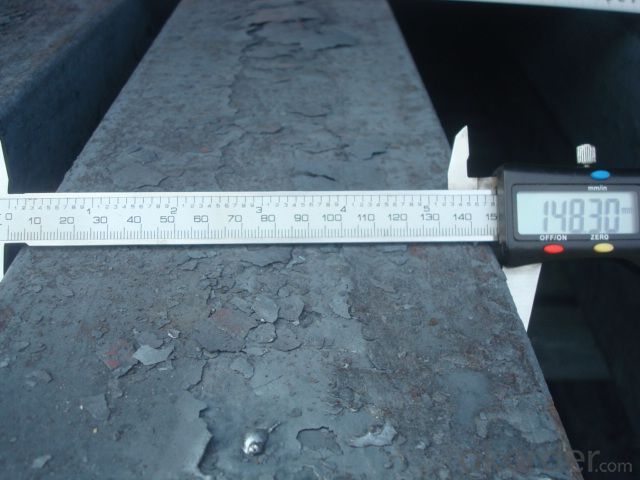
5.Usage of Steel Billet
Billets, or ingots (as they sometimes referred to), are not of practical use until they have been formed into more functional shapes and sizes. While they have already been put in the furnace, they still require a series of shaping and molding procedures such as hot and cold working, milling and cutting before they are sold in hardware stores, or used for different applications. The unformed billets, however, can be used in striking currency such as coins and as reserves, similar to gold bars.
6. Steel Billet Specification
Hot rolled billet steel
Size: 50x50mm-180x180mm
Steel Grade: 3SP, 5SP,Q195,Q235,Q255,Q275 Length:3m-12m
MOQ: 1000MT/size
Payment term: TT or LC
Packing: in bulk , bundle
Shipment: by container , bulk vessel
Packaging Details: bundles with steel strips or as customers's requirements
Delivery time: 15-30 days after the deposit
Loading port:Tianjin, or other port China
Origin :China
Inspection:Third party inspection before loading.
7.FAQ
We have organized several common questions for our clients,may help you sincerely:
1) How about your company?
A world class manufacturer & supplier of castings forging in carbon steel and alloy steel,is one of the large-scale professional investment casting production bases in China,consisting of both casting foundry forging and machining factory. Annually more than 8000 tons Precision casting and forging parts are exported to markets in Europe,America and Japan. OEM casting and forging service available according to customer’s requirements.
2) How to guarantee the quality of the products?
We have established the international advanced quality management system,every link from raw material to final product we have strict quality test;We resolutely put an end to unqualified products flowing into the market. At the same time, we will provide necessary follow-up service assurance.
3) How long can we receive the product after purchase?
In the purchase of product within three working days, We will arrange the factory delivery as soon as possible. The pecific time of receiving is related to the state and position of customers.Commonly 7 to 10 working days can be served.
4)Do you have your own QC department?
Yes, we have, our QC department will inspect the goods during the process of mass production and after completion of production.
- Q: How are steel billets used in the production of agricultural vehicles?
- The production of agricultural vehicles heavily relies on steel billets, which are semi-finished metal forms. These billets are indispensable in several stages of the manufacturing process, as they are used to construct the structural framework and essential components of agricultural vehicles. To begin with, steel billets are employed in fabricating the chassis or frame of agricultural vehicles. The exceptional strength and durability of steel make it the perfect material for this purpose. The billets are melted and shaped into the desired form, providing the necessary robustness to support the vehicle's weight and endure the harsh conditions encountered during agricultural operations. Furthermore, steel billets are utilized in manufacturing key components such as axles, wheels, and engine parts. These components require high tensile strength and resistance to wear and tear. By incorporating steel billets, manufacturers can guarantee that these parts possess the necessary qualities to withstand the demanding nature of agricultural tasks. Moreover, steel billets are also a crucial element in producing equipment attachments for agricultural vehicles. Attachments such as loaders, plows, and cultivators necessitate materials that are sturdy and robust enough to handle heavy workloads and challenging terrains. Steel billets offer the essential strength and durability to withstand the intense forces and impacts encountered during the use of these attachments. In conclusion, steel billets are of utmost importance in the production of agricultural vehicles. They are utilized in constructing the chassis, key components, and equipment attachments, ensuring that these vehicles possess the required strength, durability, and resistance to effectively carry out the demanding tasks in the agricultural industry.
- Q: What is the role of steel billets in the manufacturing of structural steel bridges?
- Steel billets play a crucial role in the manufacturing of structural steel bridges as they serve as the primary raw material for the production of steel beams and other structural components. These billets are heated and then shaped into desired forms through processes like rolling or forging. Their high strength and durability make them ideal for constructing the load-bearing elements of bridges, ensuring the structural integrity and longevity of the final bridge product.
- Q: How are steel billets used in the manufacturing of fasteners?
- Fasteners are devices utilized for the purpose of joining or securing multiple objects together, and steel billets play a vital role in their production. These billets serve as the primary material from which fasteners are created. Typically, steel billets possess a square or rectangular shape and are considered semi-finished products. To produce them, molten steel is poured into molds and allowed to cool and solidify through a process known as casting. Once the steel billets have been obtained, they undergo a series of manufacturing procedures to transform them into fully functional fasteners. These procedures encompass hot rolling, cold drawing, and machining. The initial step involves hot rolling, in which the steel billets are subjected to high temperatures and passed through a set of rollers. This process enables the billets to take on the desired shape of long, cylindrical bars or rods with a specific diameter. Following hot rolling, the bars undergo cold drawing. This process entails pulling the bars through a series of dies to reduce their diameter and enhance their surface finish. Additionally, cold drawing contributes to improving the mechanical properties of the steel, rendering it stronger and more resilient. Finally, the steel bars are machined to create fasteners with precise designs. This involves cutting, threading, and forming the bars into bolts, screws, nuts, or other types of fasteners. Subsequently, the machined fasteners undergo heat treatment processes such as quenching and tempering to further enhance their strength and hardness. In summary, steel billets hold immense importance in the manufacturing of fasteners as they serve as the raw material that undergoes various transformation processes. Through hot rolling, cold drawing, and machining, steel billets are shaped into the desired form, resulting in high-quality fasteners that meet industry standards.
- Q: What are the different methods of steel billet casting?
- There are several different methods of steel billet casting that are commonly used in the industry. These methods include continuous casting, ingot casting, and direct casting. Continuous casting is the most widely used method of steel billet casting. In this process, molten steel is poured into a water-cooled mold, which is usually made of copper. As the steel solidifies, a continuous billet is formed, which is then cut into desired lengths. Continuous casting allows for a high production rate and precise control over the dimensions and quality of the billets. Ingot casting is another method of steel billet casting, which involves pouring molten steel into individual molds to create ingots. These ingots are then allowed to solidify before being reheated and hot rolled into billets. Ingot casting is commonly used for small-scale production or for specialty steel alloys that require specific compositions. Direct casting, also known as strand casting, is a newer method of steel billet casting that eliminates the need for solidification and reheating processes. In this method, molten steel is directly cast into billets through a series of water-cooled copper molds. The billets are then cooled and cut to the desired lengths. Direct casting offers advantages such as reduced energy consumption and improved yield, as it eliminates the intermediate steps of ingot casting. Overall, the choice of steel billet casting method depends on factors such as production volume, desired quality, and specific requirements of the steel alloy being produced. Each method has its own advantages and limitations, and the selection of the appropriate method is crucial for ensuring efficient and cost-effective steel billet production.
- Q: How do steel billets contribute to the manufacturing of marine equipment?
- Steel billets are an essential raw material in the manufacturing of marine equipment. They serve as the starting point for various processes such as rolling, forging, and machining, which shape the billets into the desired components. These components, made from high-quality steel, provide strength, durability, and corrosion resistance necessary for marine equipment, ensuring their safe and reliable operation in challenging maritime environments.
- Q: How do steel billets contribute to the overall weight reduction of a structure?
- There are several ways in which steel billets contribute to reducing the overall weight of a structure. Firstly, through a process called continuous casting, steel billets can be precisely shaped and sized, resulting in lighter and more compact billets. This, in turn, decreases the weight of the structure. Secondly, advanced alloys and compositions can be used to make steel billets with high strength-to-weight ratios. These alloys are specifically designed to provide the same level of strength and durability as traditional steel, but with a lower weight. By incorporating these lightweight steel billets into the construction of a structure, the overall weight can be significantly reduced without sacrificing strength and performance. In addition, steel billets can be employed in the manufacturing of complex shapes and structures using techniques such as extrusion and forging. These methods allow for the creation of intricate designs and structures, eliminating the need for additional components and reducing the overall weight of the structure. Furthermore, steel billets can be used in the construction of lightweight structural elements such as beams, columns, and trusses. These elements can be designed to have hollow sections or thinner profiles, which reduces the amount of steel needed while still maintaining structural integrity. This results in a substantial decrease in the overall weight of the structure. In conclusion, steel billets contribute to weight reduction in structures by enabling the production of lighter and more compact components, utilizing advanced alloys with high strength-to-weight ratios, allowing for the creation of complex shapes and structures, and facilitating the construction of lightweight structural elements.
- Q: What are the different methods of corrosion protection for steel billets?
- There are several methods of corrosion protection for steel billets, including coating, galvanization, cathodic protection, and the use of corrosion inhibitors. Coating involves applying a protective layer, such as paint or epoxy, to the surface of the billets to prevent direct contact with corrosive elements. Galvanization involves coating the steel with a layer of zinc, which acts as a sacrificial anode and provides a barrier against corrosion. Cathodic protection involves connecting the steel billets to a sacrificial metal or an impressed current system to protect them from corrosion. Corrosion inhibitors are chemicals that are added to the environment or applied directly to the steel to inhibit the corrosion process. Each method has its advantages and considerations depending on the specific application and environmental factors.
- Q: Are steel billets used in the production of musical instruments?
- Yes, steel billets are used in the production of certain musical instruments. They are commonly used as a primary component in the manufacturing of steel-string acoustic guitars. The steel billets are typically shaped into a solid metal rod, which is then used to create the guitar's neck. This ensures that the instrument has the necessary strength and durability to withstand the tension of the steel strings. Additionally, steel billets can also be used in the production of other metal instruments such as drums or percussion instruments, where their strength and resilience are beneficial. However, it is important to note that the use of steel billets may vary depending on the specific instrument and its manufacturing process.
- Q: What are the advantages of using steel billets in manufacturing?
- Using steel billets in manufacturing processes has numerous benefits. Firstly, they offer exceptional strength and durability, making them ideal for applications that require heavy loads or resistance to wear and tear. This ensures that products made from steel billets are long-lasting and can withstand harsh conditions, reducing the need for frequent replacements. Secondly, steel billets are highly versatile, allowing manufacturers to easily mold and shape them into various forms. This versatility enables the creation of a wide range of products with different designs and specifications, making steel billets suitable for industries such as construction, automotive, machinery, and appliances. Furthermore, steel billets are cost-effective due to the affordability and widespread availability of steel. This ensures a steady supply and reduces production costs. Moreover, steel's durability minimizes maintenance and replacement expenses, resulting in long-term savings. Another advantage of using steel billets is their eco-friendliness. Steel is highly recyclable, promoting sustainability in the manufacturing process. By recycling steel, the need for mining raw materials is reduced, energy is conserved, and carbon emissions are decreased. Therefore, steel billets contribute to a greener manufacturing process and support environmental conservation efforts. Lastly, steel billets offer excellent performance characteristics. They have exceptional thermal and electrical conductivity properties, making them suitable for applications requiring heat dissipation or electrical conduction. Additionally, steel is resistant to corrosion, rust, and fire, providing an extra layer of protection to products manufactured using steel billets. In conclusion, the advantages of using steel billets in manufacturing include their strength and durability, versatility, cost-effectiveness, eco-friendliness, and exceptional performance characteristics. These advantages make steel billets a preferred choice for various industries, ensuring high-quality products that withstand the test of time.
- Q: What are the future trends in steel billet production?
- Some of the future trends in steel billet production include advancements in automation and robotics, increased use of renewable energy sources in the production process, implementation of more efficient and sustainable production techniques, and the development of new alloys and materials to enhance the performance and strength of steel billets. Additionally, there is a growing focus on reducing carbon emissions and improving the overall sustainability of steel production, leading to the exploration of greener technologies and practices in the industry.
Send your message to us
Continuous Casting Steel Billet in Amazing Price
- Loading Port:
- Tianjin
- Payment Terms:
- TT OR LC
- Min Order Qty:
- 1000 m.t.
- Supply Capability:
- 200000 m.t./month
OKorder Service Pledge
OKorder Financial Service
Similar products
Hot products
Hot Searches
Related keywords
